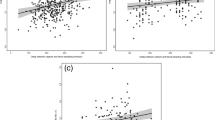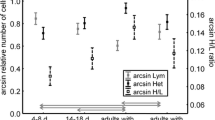Abstract
Differences in the ability to sustain chronic stress can underlie the variation in individuals’ fitness directly or indirectly by impairing the expression of condition-dependent signals used in female mate choice. Therefore, understanding the effect of the stress response on individuals’ fitness is key to identifying the mechanism of sexual selection. We tested the hypothesis that an indicator of stress—the heterophil/lymphocyte ratio (H/L ratio)—is related to several major components of male fitness in the lekking Black Grouse (Tetrao tetrix), a species with intense male–male competition. The H/L ratio accurately measured the stress response, as it increased within a few hours of trapping and during the months prior to the mating season. The H/L ratio was positively related to the expression of morphological traits, suggesting that males of higher “quality” might be able to express elaborated ornaments and better cope with stressful conditions or with changes in health status. However, in Black Grouse, ornaments are (partly) independent of behavioural display and are under only weak selective pressure. Therefore, the H/L ratio was not significantly related to male mating success and survival to the following year. Under natural conditions, observed levels of the H/L ratio might not be associated with strongly deleterious effects because of behavioural adjustments. Mechanisms other than the stress response may mediate the observed variance in male mating success.
Zusammenfassung
Die Fähigkeit, chronischen Stress auszuhalten, kann den Schwankungen individueller Fitness direkt oder indirekt zugrunde liegen, durch die Beeinträchtigung der Expression konditionsabhängiger Signale, die bei der Weibchenwahl eine Rolle spielen. Daher ist das Verständnis des Effekts der Stressreaktion auf die individuelle Fitness entscheidend, um die Mechanismen zu identifizieren, durch die sexuelle Selektion wirken kann. Wir haben die Hypothese getestet, dass ein Stressanzeiger—das Heterophile/Lymphozyten-Verhältnis (H/L-Verhältnis)—mit mehreren Hauptkomponenten der Fitness von Männchen des im Lek balzenden Birkhuhns (Tetrao tetrix), einer Art mit intensiver Männchenkonkurrenz, in Zusammenhang steht. Das H/L-Verhältnis maß akkurat die Stressreaktion, da es innerhalb weniger Stunden nach dem Fang und in den Monaten vor der Paarungszeit anstieg. Das H/L-Verhältnis stand in positiver Beziehung zu der Expression morphologischer Merkmale, was darauf hindeutet, dass Männchen höherer “Qualität” in der Lage sein könnten, aufwändige Ornamente auszubilden und besser mit Stressbedingungen oder Veränderungen ihres Gesundheitszustands fertig zu werden. Bei Birkhühnern sind Ornamente jedoch (teilweise) unabhängig von Balzverhalten und unterliegen nur schwachem Selektionsdruck. Daher stand das H/L-Verhältnis in keinem signifikanten Bezug zum Paarungserfolg der Männchen und ihrem Überleben bis zum nächsten Jahr. Es könnte sein, dass die beobachteten H/L-Verhältnisse unter natürlichen Bedingungen keine starken schädlichen Wirkungen haben, da Verhaltensanpassungen erfolgen. Andere Mechanismen als die Stressreaktion könnten die beobachtete Varianz im männlichen Fortpflanzungserfolg herbeiführen.



Similar content being viewed by others
References
Alatalo RV, Höglund J, Lundberg A (1991) Lekking in the black grouse—a test of male viability. Nature 352:155–156
Alatalo RV, Höglund J, Lundberg A, Sutherland WJ (1992) Evolution of black grouse leks: female preferences benefit males in larger leks. Behav Ecol 3:53–59
Apanius V (1998) Stress and immune defense. Adv Stud Behav 27:133–153
Ash LR, Orihel TC (1987) Parasites: a guide to laboratory procedures and identification. ASCP Press, Chicago
Birkhead TR, Fletcher F, Pellatt EJ (1998) Sexual selection in the zebra finch Taeniopygia guttata: condition, sex traits and immune capacity. Behav Ecol Sociobiol 44:179–191
Bortolotti GR, Mougeot F, Martinez-Padilla J, Webster LMI, Piertney SB (2009) Physiological stress mediates the honesty of social signals. PLoS ONE 4:e4983
Briffa M, Sneddon LU (2007) Physiological constraints on contest behaviour. Funct Ecol 21:627–637
Buchanan KL (2000) Stress and the evolution of condition dependent signals. Trends Ecol Evol 15:156–160
Buchanan KL, Spencer KA, Goldsmith AR, Catchpole CK (2003) Song as an honest signal of past developmental stress in the European starling (Sturnus vulgaris). Proc R Soc Lond B 270:1149–1156
Cabezas S, Blas J, Marchant TA, Moreno S (2007) Physiological stress levels predict survival probabilities in wild rabbits. Horm Behav 51:313–320
Candolin U (2003) The use of multiple cues in mate choice. Biol Rev 78:575–595
Carr JA (2002) Stress, neuropeptides, and feeding behavior: a comparative perspective. Integr Comp Biol 42:582–590
Creel S (2001) Social dominance and stress hormones. Trends Ecol Evol 16:491–497
Davis AK, Maney DL, Maerz JC (2008) The use of leukocyte profiles to measure stress in vertebrates: a review for ecologists. Funct Ecol 22:760–772
Dhabhar FS (2002) Stress-induced augmentation of immune function. The role of stress hormones, leukocyte trafficking, and cytokines. Brain Behav Immun 16:785–798
Dufva R, Allander K (1995) Intraspecific variation in plumage coloration reflects immune response in great tit (Parus major) males. Funct Ecol 9:785–789
Figuerola J, Munoz E, Gutierrez R, Ferrer D (1999) Blood parasites, leucocytes and plumage brightness in the cirl bunting, Emberiza cirlus. Funct Ecol 13:594–601
Folstad I, Karter AJ (1992) Parasites, bright males, and the immunocompetence handicap. Am Nat 139:603–622
Garamszegi LZ, Merino S, Török J, Eens M, Martínez J (2006) Indicators of physiological stress and the elaboration of sexual traits in the collared flycatcher. Behav Ecol 17:399–404
Greenberg N, Carr JA, Summers CH (2002) Causes and consequences of stress. Integr Comp Biol 42:508–516
Gross WB, Siegel HS (1983) Evaluation of the heterophil lymphocyte ratio as a measure of stress in chickens. Avian Dis 27:972–979
Gross WB, Siegel PB (1986) Effect of initial and second periods of fasting on heterophil/lymphocyte ratios and body weight. Avian Dis 30:345–346
Hanssen SA, Folstad I, Erikstad KE (2003) Reduced immunocompetence and cost of reproduction in common eiders. Oecologia 136:457–464
Helminen M (1963) Composition of the Finnish populations of capercaillie, Tetrao urogallus, and black grouse, Lyrurus tetrix, in the autumns of 1952–1961, as revealed by a study of wings. Riistatiet Julk 8:142–149
Hoffmann AA, Parsons PA (1991) Evolutionary genetics and environmental stress. Oxford University Press, Oxford
Höglund J, Alatalo RV, Lundberg A, Rätti O (1994) Context-dependent effects of tail ornament damage on mating success in black grouse. Behav Ecol 5:182–187
Hõrak P, Ots I, Murumägi A (1998) Haemathological health state indices of reproducing great tits: a response to brood size manipulation. Funct Ecol 12:750–756
Hovi M, Alatalo RV, Höglund J, Lundberg A, Rintamäki PT (1994) Lek centre attracts black grouse females. Proc R Soc Lond B 258:303–305
Ilmonen P, Hasselquist D, Langefors A, Wiehn J (2003) Stress, immunocompetence and leukocyte profiles of pied flycatcher in relation to brood size manipulation. Oecologia 136:148–154
Kilpimaa J, Alatalo RV, Siitari H (2004) Trade-offs between sexual advertisement and immune function in the pied flycatcher (Ficedula hypoleuca). Proc R Soc Lond B 271:245–250
Kokko H, Rintamäki PT, Alatalo RV, Höglund J, Karvonen E, Lundberg A (1999) Female choice selects for lifetime lekking performance in black grouse males. Proc R Soc Lond B 266:2109–2115
Lebigre C, Alatalo RV, Siitari H, Parri S (2007) Restrictive mating by females on black grouse leks. Mol Ecol 16:4380–4389
Lessells CM, Boag PT (1987) Unrepeatable repeatabilities: a common mistake. Auk 104:116–121
Lochmiller RL, Deerenberg C (2000) Trade-offs in evolutionary immunology: just what is the cost of immunity? Oikos 88:87–98
Lynn SE, Porter AJ (2008) Trapping initiates stress response in breeding and non-breeding house sparrow Passer domesticus: implications for using unmonitored traps in field studies. J Avian Biol 39:87–94
Maney DL, Davis AK, Goode CT, Reid A, Showalker C (2008) Carotenoid-based plumage coloration predicts leukocyte parameters during the breeding season in northern cardinals (Cardinalis cardinalis). Ethology 114:369–380
McEwen BS, Wingfield JC (2003) The concept of allostasis in biology and biomedicine. Horm Behav 43:2–15
Møller AP, Alatalo RV (1999) Good-genes effects in sexual selection. Proc R Soc Lond B 266:85–91
Møller AP, Petrie M (2002) Condition dependence, multiple sexual signals and immunocompetence in peacocks. Behav Ecol 13:248–253
Moreno J, Yorio P, Garcia-Borboroglu P, Potti J, Villar S (2002) Health state and reproductive output in Magellanic penguins (Spheniscus magellanicus). Ethol Ecol Evol 14:19–28
Mougeot F, Martinez-Padilla J, Bortolotti GR, Webster LMI, Piertney SB (2010) Physiological stress links parasites to carotenoid-based colour signals. J Evol Biol 23:643–650
Ochs CL, Dawson RD (2008) Patterns of variation in leukocyte counts of female tree swallows, Tachycineta bicolor: repeatability over time and relationships with condition and costs of reproduction. Comp Biochem Phys A 150:326–331
Ots I, Hõrak P (1998) Health impact of blood parasite in breeding great tits. Oecologia 116:441–448
Ots I, Murumägi A, Hõrak P (1998) Haematological health state indices of reproducing great tits: methodology and sources of natural variation. Funct Ecol 12:700–707
Råberg L, Grahn M, Hasselquist D, Svensson E (1998) On the adaptive significance of stress-induced immunosuppression. Proc R Soc Lond B 265:1637–1641
Rintamäki PT, Höglund J, Karvonen E, Alatalo RV, Björklund N, Lundberg A, Rätti O, Vouti J (2000) Combs and sexual selection in black grouse (Tetrao tetrix). Behav Ecol 11:465–471
Rintamäki PT, Höglund J, Alatalo RV, Lundberg A (2001) Correlates of male mating success on black grouse (Tetrao tetrix L.) leks. Ann Zool Fenn 38:99–109
Saks L, Ots I, Hõrak P (2003) Carotenoid-based plumage coloration of male greenfinches reflects health and immunocompetence. Oecologia 134:301–307
Sapolski RM, Romero LM, Munck AU (2000) How do glucocorticoids influence stress responses? Integrating permissive, suppressive, stimulatory, and preparative actions. Endocr Rev 21:55–89
Sheldon BC, Verhulst S (1996) Ecological immunology: costly parasite defences and trade-offs in evolutionary ecology. Trends Ecol Evol 11:317–321
Siitari H, Alatalo RV, Halme P, Buchanan KL, Kilpimaa J (2007) Color signals in the black grouse (Tetrao tetrix): signal properties and their condition dependency. Am Nat 169:S81–S92
Summers CH (2002) Social interaction over time, implications for stress responsiveness. Integr Comp Biol 42:591–599
Svensson E, Råberg L, Koch C, Hasselquist D (1998) Energetic stress, immunosuppression and the costs of an antibody response. Funct Ecol 12:912–919
Vleck CM, Vertalino N, Vleck D, Bucher TL (2000) Stress, corticosterone, and heterophil to lymphocyte ratios in free-living Adélie penguins. Condor 102:392–400
von Schantz T, Bensch S, Grahn M, Hasselquist D, Wittzell H (1999) Good genes, oxidative stress and condition-dependent sexual signals. Proc R Soc Lond B 266:1–12
Wingfield JC, Kitaysky AS (2002) Endocrine responses to unpredictable environmental events: stress or anti-stress hormones. Integr Comp Biol 42:600–609
Wingfield JC, Sapolsky RM (2003) Reproduction and resistance to stress: when and how. J Neuroendocrinol 15:711–724
Acknowledgments
We are grateful to Elina Virtanen for help in the lab, Victor Apanius for guidance in leukocyte identification, Judith Morales for guidance in cell counting, Panu Halme, Heikki Helle, Laura Häsä and Matti Halonen for field assistance, and Maxine Iversen for improving the English. Anders Møller, Jacob Höglund, Jan Lifjeld and Jesus Martinez-Padilla gave insightful comments on previous drafts of the manuscript. This project was founded by the Academy of Finland (grant nos. 7211271 and 7119165) and the Finnish Centre of Excellence in Evolutionary Research. This research was carried out in compliance with the current laws of Finland and received permission from the Central Finland Environmental Centre and the Animal Care committee of the University of Jyväskylä.
Author information
Authors and Affiliations
Corresponding author
Additional information
Communicated by C. G. Guglielmo.
Rights and permissions
About this article
Cite this article
Lebigre, C., Alatalo, R.V., Kilpimaa, J. et al. Leucocyte counts variation and measures of male fitness in the lekking Black Grouse. J Ornithol 153, 95–102 (2012). https://doi.org/10.1007/s10336-011-0701-6
Received:
Revised:
Accepted:
Published:
Issue Date:
DOI: https://doi.org/10.1007/s10336-011-0701-6




